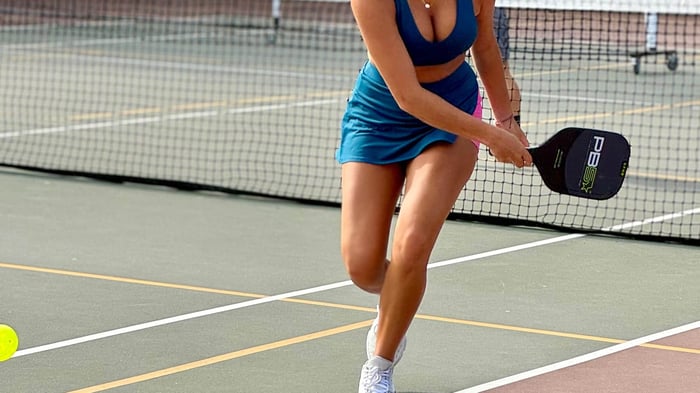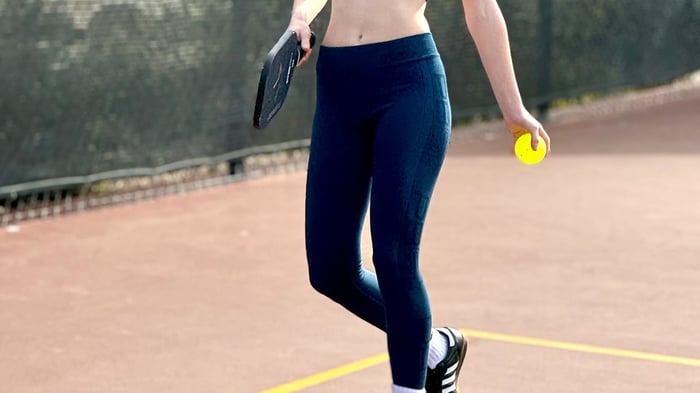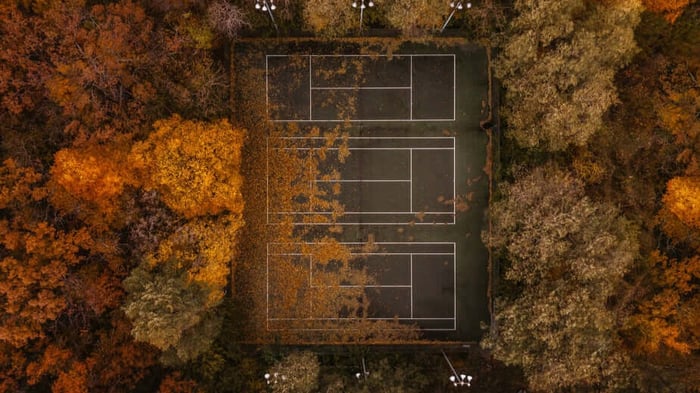Key takeaways:
A volley in pickleball is a shot taken out of the air before the ball bounces. It's a core technique for controlling the pace, applying pressure, and winning quick exchanges at the net.
Proper grip, stance, and positioning are essential for effective volleying. Focus on using the Continental grip, staying light on your feet behind the kitchen line, and maintaining a compact swing for better control.
Improving your volleys takes consistent practice and the right gear. Drills, thoughtful technique, and balanced paddles—like those from PB5star—can help you stay sharp, confident, and ready to dominate net play.
Have you ever witnessed a pickleball match where players engage in rapid-fire exchanges at the net, showcasing quick reflexes and strategic finesse? These thrilling moments are the result of volleys, a core element of dynamic pickleball play. A volley in pickleball occurs when a player strikes the ball in mid-air before it bounces on their side of the court, a technique that can swiftly change the momentum of a rally.
What is volleying in pickleball, and why does it matter? Volleying in pickleball allows players to control the pace, apply pressure, and dominate the net with quick hands and smart placement. It’s a vital skill that keeps your opponents guessing and your rallies exciting.
Volleys play a pivotal role in pickleball, especially during doubles matches where much of the action unfolds near the kitchen line. Mastering this skill not only enhances individual performance but also elevates the overall game experience, creating more engaging and enjoyable matches for everyone on the court.
At PB5star, we're passionate about helping players feel their best during these intense moments. Explore our collection to discover how our gear can support your pickleball journey and help you make the most of every volley opportunity.
What is a volley in pickleball?
A pickleball volley occurs when you strike the ball before it bounces on your side of the court. This swift, mid-air shot is a powerful tool in your pickleball arsenal, allowing you to seize control of the rally and keep your opponents on their toes. Want to take your game to the next level? Mastering the volley in pickleball is your ticket, especially in doubles matches where much of the action unfolds near the kitchen line.
Definition of a volley
In simple terms, a volley in pickleball is any shot where you hit the ball out of the air, before it has a chance to bounce on your side of the court. This differs from groundstrokes or dinks, which are played after the bounce.
Volleys are often used near the non-volley zone (the kitchen) and require quick reflexes and precise timing. Whether it's a soft block or an aggressive punch, volleying in pickleball helps players stay on offense and end points quickly.
To excel at pickleball volleys, your positioning and footwork are key. Stay light on your feet and keep your paddle up in the ready position behind the kitchen line. This athletic stance improves your reaction time and helps you cover more court during those intense volley exchanges. This preparation is crucial for successful volleying.
If you're new to pickleball volleys, you might be tempted to swing hard or add spin. But here's a pro tip: focus on control and placement instead. Use a short, compact motion, swinging from the shoulder rather than the wrist. Aim to keep your volleys low, and resist the urge to return low volleys with power. Remember, in pickleball, consistency often trumps raw power. By honing these fundamental volley techniques, you'll see your overall game improve in no time.
Techniques for volleying
Volleying in pickleball is about more than just quick hands—it’s a combination of grip, stance, timing, and practice. To build a reliable pickleball volley, it’s important to understand the mechanics behind each movement and how they work together.
From how you hold your paddle to how you position your feet, small adjustments can make a big difference during fast-paced net play. Let’s break down the key techniques that form the foundation of strong, consistent volleying in pickleball.
Proper grip for a pickleball volley
Your grip on the paddle is the cornerstone of a strong volley game. A well-executed pickleball volley grip empowers you to control the paddle with precision, blending power and finesse for each shot. In the fast-paced world of pickleball volleys, three main grips stand out: the Continental, Eastern, and Western. Each offers unique advantages, but mastering the Continental grip can significantly enhance your pickleball volley technique.
The Continental grip shines in pickleball volley situations where quick reactions are paramount. It allows for seamless transitions between forehand and backhand shots without adjusting your grip, a valuable asset in rapid exchanges at the net. To find this grip, hold the paddle as if you're shaking hands with it, with the edge facing upwards. While it might feel unfamiliar initially, practice will reveal its versatility in volley play.
The Eastern grip, reminiscent of a tennis grip, offers solid control for forehand volleys and is worth exploring as you develop your personal style.
As you refine your pickleball volley skills, experiment with different grips during practice sessions. Pay attention to what feels natural and effective for your playing style. A comfortable, consistent grip is key to maintaining shot accuracy and power in volleys. Remember, the joy of pickleball lies not just in personal improvement, but in the shared experience of exciting rallies with friends and competitors.
Correct stance for a pickleball volley
Your stance forms the bedrock of a powerful and precise volley in pickleball. A balanced, ready position not only sharpens your reaction time but also allows for quick adjustments during those exhilarating net exchanges.
To nail the ideal pickleball volley posture, plant your feet shoulder-width apart, facing forward, with a slight bend in your knees. Keep your back gently curved and your arms poised for action, paddle up and in front of your body. This readiness primes you for swift movements and helps you cover more court effectively.
Balance and preparedness are the secret ingredients to a strong volley stance. By staying light on your feet and evenly distributing your weight, you'll be set to move in any direction at the drop of a hat. Position yourself just behind the non-volley zone line (often called the "kitchen line" in pickleball lingo) to minimize openings on your side of the court.
This strategic placement makes it tougher for your opponents to find gaps and keeps you in the heart of the action. A well-balanced stance allows you to smoothly transition between offense and defense, a valuable skill in the dynamic world of pickleball volleys.
To keep your stance solid throughout a match, focus on staying relaxed yet alert. Avoid locking your knees or planting your feet flat – this can slow you down. Instead, try a gentle bounce on the balls of your feet to stay nimble. As you fine-tune your volley stance, you'll likely notice improvements across your entire game.
Mastering body positioning and paddle angle
Beyond your stance, how you align your body and angle your paddle can determine whether your pickleball volley is effective—or easily returned. Good volleying starts with minimizing unnecessary motion and maximizing control.
Square your shoulders to the net. This helps you maintain balance and adjust quickly. Angling your body too much can reduce your reach and open up gaps in your defense.
Keep your paddle face slightly open. This lets you absorb fast shots and control the ball’s direction without overhitting. A paddle face that’s too flat or angled downward can cause pop-ups or missed volleys.
Engage your core. A stable core helps transfer energy from your lower body to your arms during the volley. It also improves balance and reduces fatigue during long exchanges.
Adjust your paddle angle based on incoming speed. For fast shots, use a firmer grip and less paddle motion—just block or guide. For slower shots, add a gentle push or punch to maintain momentum without overswinging.
These small, intentional movements add up. By pairing proper footwork with body control and paddle angle, you’ll be better prepared for any volleying challenge at the net.
Beginner-friendly drills
Mastering the volley in pickleball requires dedication, and these beginner-friendly drills will help you build a solid foundation. Regular practice of these exercises will enhance your reaction time and technique, setting you up for success in those fast-paced volley exchanges.
Wall Volleys: Stand about 3-4 feet from a wall and gently hit the ball against it, alternating between forehand and backhand volleys. Focus on maintaining a consistent height and pace.
Partner Volleys: Face your partner at the non-volley zone line, taking turns to volley the ball back and forth. Start slow and gradually increase the pace as you become more comfortable.
Dink-to-Volley: Begin with dinking exchanges at the kitchen line, then transition to volleys. This drill helps you practice moving from soft shots to quick volleys seamlessly.
Reaction Volleys: Have a partner feed you balls at varying speeds and angles while you stand ready to volley. React quickly to each shot, improving your reflexes and paddle control.
Remember, consistent skill development is key for competitive play. As you work through these drills, focus on maintaining proper form and gradually increasing your speed and precision.
Common volleying mistakes
As you refine your pickleball volley techniques, be mindful of these areas for improvement. By recognizing and addressing these common pickleball errors, you'll enhance your volley skills and overall game:
Overactive wrists: Let your shoulders and arms do the work. This approach ensures better control and consistency in your volleys.
Big backswings: Keep your backswing compact. A short, controlled motion leads to more accurate volleys and quicker reactions at the net.
Crowding the ball: Give yourself enough space to strike the ball comfortably. This allows for cleaner contact and improved shot placement.
Neglecting footwork: Set your feet before hitting. Stable footing provides a solid foundation for accurate pickleball volleys and helps you recover quickly for the next shot.
Tense grip: Maintain a relaxed grip on your paddle. This allows for better feel and control, leading to more precise volleys.
At PB5star, we're committed to supporting your growth on the court. Our performance-driven apparel is designed to move with you, allowing you to focus on perfecting your technique without distractions. With the right mindset, practice, and gear, you'll be mastering these pickleball volley techniques in no time!
Tips from the pros
If you're just starting out or looking to sharpen your edge at the net, improving your pickleball volley technique takes more than repetition. It’s about understanding timing, positioning, and paddle control—all of which play a role in volleying in pickleball. Here are key tips to help you build stronger, more effective volleys on the court:
Prioritize paddle position: Keep your pickleball paddle up and centered at chest height when preparing for a volley in pickleball. This “ready” position shortens your reaction time and allows you to cover both forehand and backhand angles with ease. Dropping the paddle below your waist makes it harder to defend quick shots at the net.
Move through the shot, not just your arms: Many players try to rely solely on their arm for power, but successful volleying in pickleball often involves the entire body. Shift your weight forward slightly as you make contact. This adds stability and control, helping you place the ball more accurately.
Watch the contact point: For every pickleball volley, aim to meet the ball slightly in front of your body. Too far back, and you lose power and control. Too far forward, and you risk pushing it into the net. Practicing controlled wall volleys can help you build a feel for this ideal contact zone.
Choose placement over power: A well-placed volley in pickleball—especially into the opponent’s feet or toward open court—is often more effective than a hard hit. Focus on guiding the ball where they can’t easily return it. Think of it as chess, not boxing. Precision wins points.
Stay behind the kitchen line: Footwork matters. Stay alert and avoid drifting into the non-volley zone during exchanges. A clean pickleball volley must be executed behind the kitchen line unless the ball bounces first. Practicing small lateral steps can help you maintain this legal positioning during pressure points.
Use your opponent’s power: In fast rallies, you don’t need to generate your own force. Let the ball’s speed do the work. A soft block or redirection is often enough to send it back effectively. This is one of the smartest strategies in volleying in pickleball, especially during doubles play.
Frequently asked questions
What is a volley in pickleball?
A volley in pickleball is a shot where you hit the ball out of the air before it bounces on your side of the court. Volleys are commonly used near the net during fast-paced exchanges and help players stay on the offensive. They must be executed behind the non-volley zone (kitchen) line unless the ball bounces first.
What does volley mean in pickleball?
In pickleball, volleying means striking the ball before it touches the ground. It’s a technique used to maintain pressure, speed up play, and catch opponents off guard—especially during doubles play. Effective volleying requires control, timing, and smart positioning near the kitchen line.
How do I improve my volley in pickleball?
To improve your pickleball volley, focus on four fundamentals:
Use the Continental grip for quick transitions
Maintain an athletic stance just behind the kitchen line
Practice controlled, compact motions using shoulder-driven swings
Work on reaction drills like wall volleys or partner feeds to sharpen timing
With consistent practice, your volleying will become more confident and precise.
What paddle is best for volleying in pickleball?
When it comes to volleying in pickleball, the right paddle can make a big difference. Look for a paddle that offers both control and stability—especially during quick net exchanges. PB5star’s control and balance paddles are designed with fast hands and compact swings in mind, giving you the responsiveness you need without sacrificing touch.
Why is balance important when volleying in pickleball?
Balance is essential because it allows you to react quickly and place your volleys with accuracy. Without it, you're more likely to mistime shots or leave your side of the court exposed. That’s why PB5star gear emphasizes comfort and movement support—so your focus stays on the rally, not your footing.
Take your pickleball volleys further with PB5star
Mastering the volley in pickleball is like unlocking a secret weapon, one that can transform your play from reactive to proactive and ignite your passion for the game. As we've explored together, proper technique, mental preparation, and consistent practice are the pillars of volley excellence.
Remember, a well-executed volley isn't just about power - it's about precision, strategy, and the thrill of keeping your opponents on their toes. The pickleball market is projected to reach $317.94 million by 2031, reflecting our growing community's love for this dynamic sport. As you continue to refine your volley skills, imagine how the right gear could amplify not just your performance, but your enjoyment of every rally.
At PB5star, we're not just about creating apparel - we're about nurturing the pickleball community and fueling your passion for the game. Our gear is meticulously crafted to move with you, allowing you to focus on perfecting those crucial volleys and sharing exhilarating exchanges at the net. Ready to take your volley game to new heights and connect with fellow enthusiasts? Explore our collection and join the PB5star family. Together, let's celebrate the joy of pickleball and elevate our shared experience on the court!






